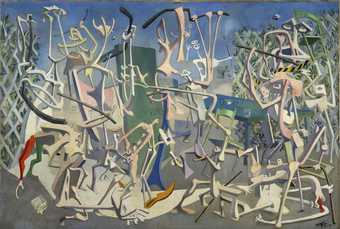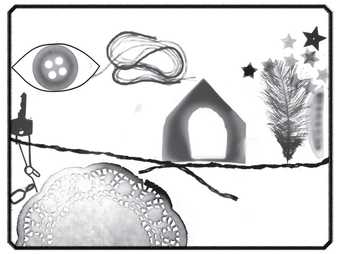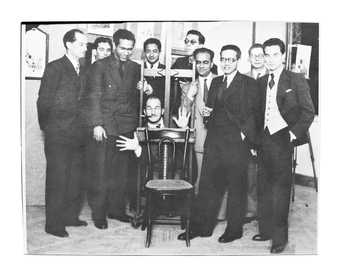
Mayo, Coups de Bâtons 1937. Image courtesy: Private collection, Milan.
Surrealism in Egypt: Art et Liberté 1938–1948 is the first comprehensive museum exhibition about surrealist collective Art et Liberté. The group was made up of artists, writers and political activists working in Cairo, including the poet Georges Henein, painters such as Ramses Younane and Amy Nimr, and the American photographer Lee Miller. Founded upon the 1938 publication of their manifesto 'Long Live Degenerate Art', it provided a restless generation with a platform for cultural and political reform. The manifesto's title, named for the label the Nazi party gave to art they did not approve of, reflected the group's defiance of fascism, nationalism and colonialism.
When Art et Liberté first emerged it was against a backdrop of highly conservative state-endorsed exhibition practices. Highly partisan and underscored by nationalism, such exhibitions classified artists according to nationality. The group, in keeping with established principles of surrealism, rebelled against the alignment of art with political propaganda in both their artwork and across various self-published writings. They also rejected the notion of art for art's sake whereby pictures had become a platform for the recycling of allegories and metaphors that did nothing to challenge the status quo.
Through its own definition of surrealism, the Art et Liberté group was as much globally engaged as it was rooted in local artistic and political concerns. Playing an active role within an international network of surrealist writers and artists, they achieved a contemporary literary and pictorial language. This exhibition charts an all-encompassing presentation of Art et Liberté, shedding new light on our understanding of modernism through this group's artistic contributions and their negotiation of surrealism in Egypt.
The Voice of Canons
Art et Liberté's resolve to affect social and cultural change was only hardened in the face of fascist ideologies that, beyond their firm grip over Europe, had been on the rise in Egypt since the early 1930s. While Cairo was not on the frontlines of war, Egypt – under ongoing British political influence – put its national resources, along with its entire infrastructure, at the disposal of the British. By 1941, 140,000 soldiers were stationed in Cairo alone, and troops and tanks swarmed the city streets.
A profound engagement with the war, and the destruction that it caused, informed the whole spectrum of Art et Liberté's output. Surrealist depictions of battlefields and images of destruction capture the state of anxiety, and the content and themes of the works of several Art et Liberté members reflect on their experiences of conflict.
Fragmented Bodies
During the time of Art et Liberté, Cairo was a city marked by extreme inequality. The majority of wealth was held by a small percentage of feudal landowners and business magnates, while more than half of the population, mostly rural labourers and urban workers, suffered from dire poverty. Art et Liberté believed that this unfair distribution of resources was maintained by the prevailing economic, social and cultural mentality, manifested in broader cultural trends, such as the championing of national symbolism and realism in visual art.
In these traditional styles, bodies were portrayed in an idealised fashion. In contrast, Art et Liberté painted deformed, dismembered or distorted figures, and the motif of the fragmented, or emaciated body, as Art et Liberté called it, became a site of social as well as artistic protest, illustrating the distinct economic injustice that plagued their society. Through paintings that ranged from the miniscule to the monumental, Art et Liberté portrayed the body in a state of anguish within violent settings. These gained in resonance given the simultaneous unfolding of the Second World War and the increased circulation of images of maimed soldiers amid scenes of battles and destruction.
The Woman of the City
Women such as Amy Nimr, Inji Efflatoun, Ida Kar and Lee Miller played an essential role in introducing and developing surrealism in Egypt. The active part they played contributed to a strong feminist agenda, evident in many Art et Liberté publications such as al-Tatawwur and Don Quichotte. This concern took on a specific manifestation during the war years, when due to severe poverty and the massive influx of soldiers, a large number of women were driven into prostitution.
Henein addressed the issue in his poem Saint Louis Blues, dubbing a suffering prostitute the 'woman of the city', while visual artists explored the theme in many paintings, depicting prostitutes as solitary figures within surrealist settings. Their bodies mutilated and distorted, some were pierced with nails, while monster-like trees ravaged others. Unlike some practices associated largely with Parisian surrealism, which idealised or eroticised the female form as a sexual object, Art et Liberté critically illuminated the issue by portraying the injustices prostitutes were faced with.
Writing with Pictures
One of the defining characteristics of Art et Liberté's creative expression is the close correlation between their visual art and literature. Often, a poem by one of the group members would provide the subject matter for another member's painting. Similarly, a painting would inspire certain scenes in one of the group writers' short novels.
Several Art et Liberté painters were called upon by their fellow group writers to illustrate their publications. Kamel El-Telmisany illustrated Georges Henein's Déraisons d'être 1938, and Albert Cossery's Les hommes oubliés de Dieu 1941, for which Ramses Younane illustrated the English edition's cover in 1944. Between 1940 and 1943, Fouad Kamel embarked on a series of portraits where a woman slumbers in a meditative trance-like state. In most of these, two objects continue to appear: a candle and a marijuana plant. Kamel's haunting imagery owes much of its detail and power of expression to a number of literary images that recur in Albert Cossery's twisted love story The Girl and the Hashish-Smoker, first published in Cairo in 1940. Kamel vividly translated the scenes of Cossery's story of poverty and addiction into paintings of a surrealist nature.
This dialogue between painting and literature underpins a cycle of creative output that marks the distinct interdisciplinary nature of Art et Liberté. Between 1939 and 1940, Art et Liberté produced three innovative journals: Don Quichotte in French, al-Tatawwur in Arabic and the bilingual Bulletin Art et Liberté. From the early 1940s and into the mid-1950s they also ran two publishing houses, Les Éditions Masses and La Part du Sable, which disseminated the writings of predominantly francophone authors such as Albert Cossery, Edmond Jabès and Gherasim Luca.
Subjective Realism
Leading Art et Liberté theorist and painter Ramses Younane depicted surrealism as a movement in crisis. Identifying two types of surrealism, the first, best exemplified by Salvador Dalí and René Magritte's absurd juxtapositions, was considered excessively pre-meditated, leaving no space for the uncontrolled imagination. The second, consisting of automatic writing (pioneered by Breton and adapted to drawing), was deemed too self-centred and not geared enough towards collective empowerment.
Younane thus identified the need for a new type of surrealism, which he called 'subjective realism'. According to this new definition, artists could freely adopt the formal style of their liking or reflect on any subject they were interested in (subjective). Consciously seeking to make use of symbols and settings that were easily recognisable by the public they drew from a wide range of sources. These could vary from an ancient Pharaonic motif or a desert landscape, to a familiar architectural edifice or even a world famous work of Opera (realism).
Subjective realism's demand from the artist to find a recognisable visual expression of the unbridled impulse of the subconscious illustrates Art et Liberté's negotiation of surrealism, and their desire to make it more effective within their immediate context. Kamel El-Telmisany, another Art et Liberté theorist and artist, referred to this method as free art, and group members used these two terms interchangeably as they sought to develop a distinct visual language. This new 'collective mythology' as Younane described it, was believed to be the vehicle by which surrealism could better affect a social and moral revolution as well being an art movement.
The Contemporary Art Group: 'An Egyptian Art'
In 1946, a number of younger Art et Liberté members cofounded an independent collective under the name of the Contemporary Art Group. The group remained active until the mid-1950s and a few of its members, such as Abdel Hadi el- Gazzar, Hamed Nada and Samir Rafi, would later become some of Egypt's leading modern artists. From the late 1940s until the early 1960s, the question of how art can be made authentically Egyptian – furthered by the Revolution of 1952, and the nation-building project that followed in its wake – became a core concern for artists and intellectuals alike.
The Contemporary Art Group, diverting from surrealism, turned instead to a local vernacular consisting of symbolic iconography, succeeding in being perceived by the public as a movement that established the first truly modern Egyptian art. On the other hand, the main artists of Art et Liberté, who had disbanded in 1948, saw the Contemporary Art Group – reverting to more traditional, realist means – as becoming a mouthpiece for a new form of nationalism.
The Surrealist Photo
In the late 1930s, numerous surrealist photographers emerged from the Art et Liberté group, including Ida Kar, Etienne Sved, Ramzi Zolqomah and Van Leo. Their work made use of techniques central to surrealist photography, such as solarisation (in which partially developed photographs are exposed to light) and photomontage, whereby a collage is constructed from disparate images, to reflect the unconscious mind. Lee Miller, who had pioneered solarisation with Man Ray (who produced some of the most celebrated photographs of the modern era), resided in Cairo from 1933 until 1939, and was closely associated with Art et Liberté. She produced some of her most striking surrealist photography during that period.
The group created absurd images in which they further explored the deconstruction of the human form, and the alienation of the familiar within diverse surrealist settings. In a similar vein to how other surrealist photographers employed primitive masks and objects in order to criticise the colonial vision of the world, Art et Liberté used photography to highlight the nationalist exploitation of Pharaonic Egypt. They challenged the viewer's familiar perception of ancient monuments and artefacts through playful compositions and absurd juxtapositions, to create some of their most strikingly surreal images.
Georges Henein
The surrealist poet and provocateur Georges Henein played a central role in the founding of Art et Liberté. Born in Cairo in 1914 to an Egyptian diplomat father and an Egyptian-Italian anti-fascist mother, Henein experienced cosmopolitanism from a young age spending his early years between Egypt, Italy, Spain and France. He started introducing surrealist ideas to Egypt as early as 1934 through various publications, and met international surrealism's founder André Breton in Paris two years later. In 1937, Henein delivered a seminal lecture on surrealism in Cairo, foreshadowing the movement's introduction to Egypt, and he would be the main contributor to the following year's founding manifesto of Art et Liberté. In 1947, Breton made him a member of CAUSE, an international coalition for post-war surrealists. Henein's loyalty to Breton came to an end in 1948 due to increasing disagreements in vision. This rupture, along with increasing local political challenges ultimately led to the dissolution of Art et Liberté.


